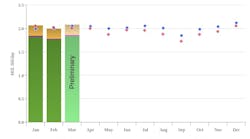The Woodside Petroleum Ltd.-led North West Shelf project participants have entered the front-end engineering and design phase with Hess Exploration Australia to process gas from the undeveloped Equus gas fields that lie within Hess’s WA-390-P permit in the Carnarvon basin offshore Western Australia.
This confirms a deal made between the Woodside group and Hess in December 2014.
The FEED work includes examination of the technical aspects as well as a progression of key commercial agreements so that participants can make a proposed final investment decision in 2017.
The Equus project will require a $6-billion investment on offshore gas development and will be the first time that the NWS JV has processed gas from a third party.
The intention is that Hess will deliver gas to the NWS project’s offshore system for sending down the pipeline to the Woodside JV’s LNG processing plant at Karratha on the Burrup Peninsula.
Hess, which has 100% of Equus fields, will then take responsibility for marketing and delivering its own gas volumes.
The Equus project entails development of eight gas fields discovered by Hess in WA-390-P between 2008 and 2012 with reservoirs in several stratigraphic horizons. The fields lie southeast of ExxonMobil Corp.-BHP Billiton Ltd.’s Scarborough gas field and southwest of ExxonMobil’s Jansz-Io gas field.
The eight fields are Mentorc, Bravo, and Nimblefoot with Cretaceous-age reservoirs; Chester and Rimfire with Cretaceous-Triassic reservoirs; Glenloth and Briseals in Triassic sands; and the Glencoe discovery in the Jurassic. The fields lie in 1,000-1,200 m of water and are 300 km west of the NWS gas plant on the Burrup.
In total the fields are thought to have recoverable reserves of 2-3 tcf of gas. The three Cretaceous fields have the highest condensate-gas ratio of 40 bbl/MMcf.
Development plans include up to 18 subsea production wells plus manifolds and flowlines tied to a semisubmersible production system for preliminary processing and gas compression and a gas export line to the NWS offshore facilities.
